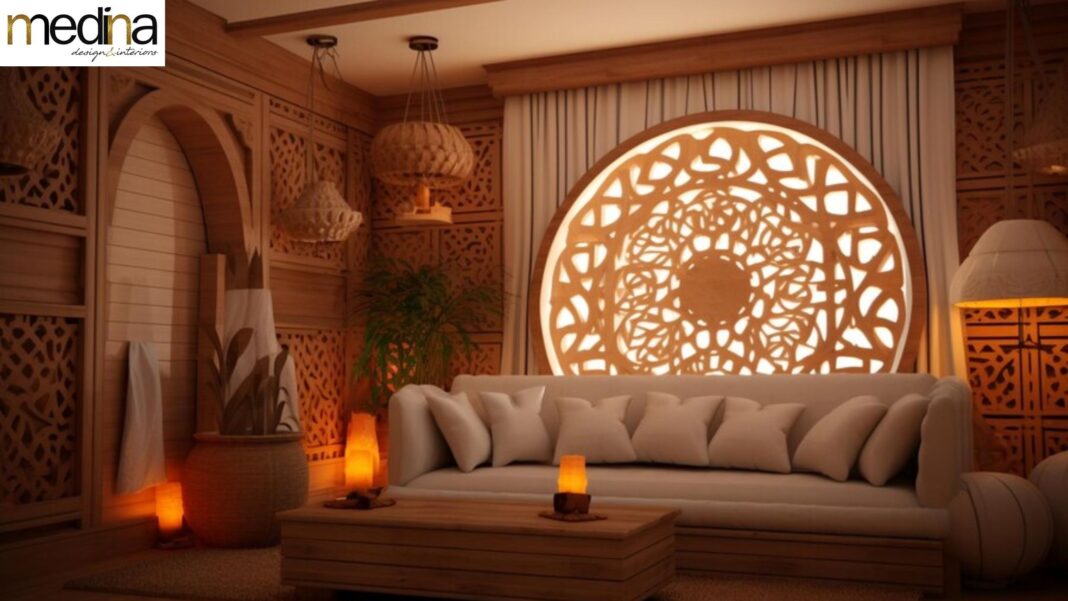Islamic home decoration or design beautifully blends spirituality, culture, and comfort to create a peaceful and meaningful living space. Every element in a Muslim home reflects values of simplicity, balance, and faith. By thoughtfully integrating key design principles, such as clean layouts, natural light, and functional furniture, you can craft a space that nurtures both body and soul.
Whether it’s incorporating Islamic art, choosing earthy colour tones, or setting up a designated prayer area, these touches help connect your home with Islamic teachings. Therefore, discover eight essential tips for decorating a Muslim home to enhance its spiritual and aesthetic appeal.
1. Begin with Clean, Simple Layouts
Islamic teachings cherish simplicity and balance. A simple layout reflects these values. Avoid clutter and unnecessary furniture. Make sure each space has a clear job. Use fewer items, but make each one meaningful. Therefore, a tidy design creates a peaceful feeling, perfect for thinking and praying.
- Open spaces welcome comfort.
- Pick furniture that does more than one job.
- Keep everything balanced in each room.
A simple design makes cleaning easier. It also creates a calm home, great for family life.
2. Add Islamic Art and Calligraphy
Islamic art sparkles with geometric shapes, floral designs, and calligraphy. These elements lift the spiritual atmosphere of a Muslim home. Hanging verses from the Quran is a common practice. Calligraphy and Islamic art show the beauty of faith. Additionally, they serve as gentle reminders of Allah’s presence.
- Use Islamic calligraphy as wall art.
- Bring in geometric patterns on rugs, tiles, or wallpaper.
- So, place framed Quran verses in living rooms.
These designs add decoration and spirituality. Moreover, they help shape the core of Islamic home design, giving a sense of identity and purpose.
3. Pick Neutral and Earthy Colours
The colours in Islamic home design stay soft and calming. Neutral and earthy shades work best. Here, colours like white, beige, brown, and green signal peace and calm. Therefore, they mirror nature, a key theme in Islamic culture.
- Choose soft tones for furniture, walls, and decor.
- Use natural materials like wood, clay, or stone.
- Add hints of gold or blue to stand out.
These colours create a peaceful setting. Thus, they also link the home with nature, which is central to Islamic beliefs.
4. Design a Special Prayer Area
A prayer space is a must in a Muslim home. It should feel clean, quiet, and free from distractions. This is where daily prayers (Salah) take place. Having a set spot for prayer keeps the home in tune with Islamic values. Clearly, this area should be easy to reach but separate from the main living areas.
- Lay out a prayer mat (sajjadah) in this space.
- Use shelves for Quran and prayer beads (tasbih).
- Additionally, keep the area simple and focused.
This space serves as a calm retreat for worship. Thus, it also strengthens the spiritual core of Islamic home decoration.
5. Invite Natural Light
Islamic architecture often celebrates natural light. Sunlight holds symbolic meaning in Islam, representing clarity and guidance. Homes should allow natural light to pour in. Large windows, skylights, and open areas work perfectly for this.
- Use light curtains to let sunlight stream through.
- Place mirrors to bounce light around.
- Keep rooms well-lit during the day.
Natural light invites warmth and a cheerful glow. In addition, it also adds charm to the home’s overall look.
6. Use Practical and Comfortable Furniture
Comfort and purpose matter in Islamic home design. Furniture should feel both useful and cosy. Each piece should have a clear job. Avoid fancy or showy designs that serve no purpose. Instead, choose items that offer comfort and usefulness.
- Pick furniture that is simple but cosy.
- Put comfort first, not style.
- Consider low seating, common in traditional Islamic homes.
Practical furniture helps create a peaceful home. Furthermore, it reflects simplicity, a key value in Islam.
7. Bring in Natural Elements
Islam encourages a deep appreciation for nature, as it reflects the beauty and wisdom of Allah’s creation. By introducing natural elements into your home, you strengthen this connection and bring a sense of harmony with the environment. Plants, water features, and natural materials like wood, stone, or clay can significantly enhance the spiritual atmosphere in a Muslim home.
Indeed, these elements not only beautify the space but also create balance, calm, and tranquillity. Indoor plants freshen the air, while water features offer soothing sounds that invite reflection and peace. Therefore, natural materials add warmth and depth, reminding us of the natural world’s simplicity and elegance.
- Decorate with indoor plants or a small garden.
- Use water fountains for a peaceful touch.
- Therefore, choose natural materials for floors and furniture.
Natural elements freshen the air and create a calm space. Additionally, they also symbolise Allah’s beautiful creations.
8. Ensure Privacy in Your Design
Privacy is important in Islamic home decoration. Homes should offer privacy, especially for women. You can achieve this through smart architectural choices and design. Moreover, window coverings and room dividers help keep spaces private.
- Use curtains or blinds on windows.
- Add room dividers in open spaces.
- In addition, use frosted glass for extra privacy.
Privacy makes families feel safe and comfortable. In addition, it matches Islamic values of modesty.
The End Note
Overall, designing a Muslim home goes far beyond mere style; it’s about creating a space that reflects core Islamic values and traditions. Each element, from simple layouts to designated prayer areas, serves a distinct and meaningful purpose. The focus remains on simplicity, balance, and functionality, ensuring that the home is both practical and spiritually uplifting.
Islamic art, natural light, and soothing, earthy colours contribute to a serene atmosphere that encourages peace and reflection. By incorporating these eight essential tips for decorating a Muslim home, you can create a space that is not only beautiful but also aligned with your faith, nurturing both body and soul.


